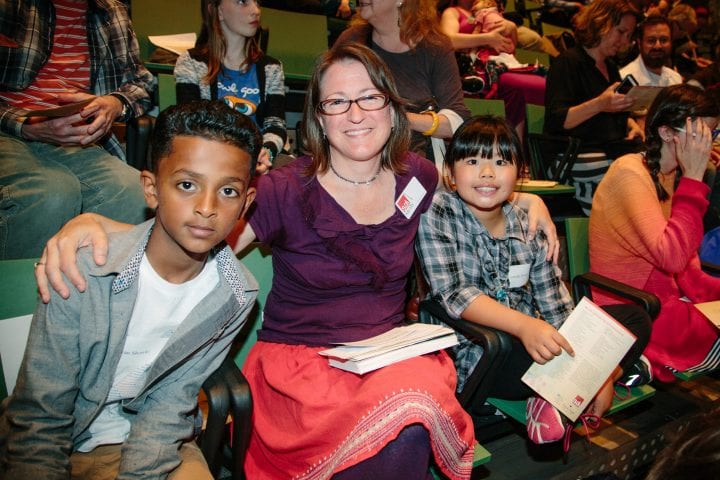
WITS Voices: Revision—To See Again
March 2, 2018
By Katy Ellis, WITS Writer-in-Residence
I have to admit revision has never been my strong point as a writer. Only in the last ten years have I truly grasped the fact that my second (or third or fourth or tenth) draft better says what I wanted to say in the first place. Now, I actually enjoy the work of revision or seeing again those old poems that need strengthening. I blame this late-in-life revelation for the difficulty I have when it comes to teaching revision. It seems every time I look again at how I teach revision, I revise my revision lesson.
The emerging poets I work with—kindergarten, first and second graders—have only recently learned to make the shapes of letters on the page. It’s no wonder that they might resist revising a poem that took hard-fought effort to sound out and print on the page in an order that makes sense to the world. In the past, I’ve made much too elaborate check lists for them to work through as they make changes to their poems. I’ve also asked them to re-write the poem as neatly as they can on a new sheet of paper (this is almost like a punishment to some kids!). We’ve created a simple classroom thesaurus so they can have an array of ways to say “awesome” or “big.” We’ve made lists of exciting action words instead of saying the bird “goes” up in the sky. Every time I teach revision, it’s different. And the results always vary.
This winter I wrung my hands (again) as I carefully planned my revision class for my second graders at Broadview Thomson K-8. Next morning, after parking my car I scrapped everything I’d planned and decided I would present three words: ADD, CUT, REPLACE and see what my students thought these words meant in relation to revision. What proceeded were discussions that wove together all the elements from my previous revision classes but in the time and manner each class needed.
Some students made daring changes to their work. For example, Francoise removed the entire scaffolding of her Cloud Field Guide Poem, added more detail and when she copied the second draft onto a new page, she added line breaks!
Draft 1
Cloud Field Guide
Cloud Name: Blue Diamond
Cloud Description: She only flies through
the night sky moonlight
And she never is seen in the day time.
Cloud’s Hopes and Dreams: My cloud dreams
that she could make things with herself, to make
beautiful things.
Cloud’s Greatest Fear: is the sun. She only likes
the moonlight, not the sunlight. She’ll melt if
she sees it.
Note: If you see this cloud it means you get
good luck at night. And you might get a present
from it.
Draft 2
Blue Diamond
She only flies through the moonlight.
And she is never to be seen in the sun.
My cloud’s dream
is to make things with herself like diamond
earrings or dresses or necklaces or bracelets
or even shoes!
She will turn into a gooey,
slimy, icky puddle
if she sees the sun at day time.
She’ll just disappear with her powers!
If you see my cloud at night
you’ll have really good luck.
You might even get a present
like a diamond crystal or emeralds.
***
Second Grader Mac was quite attached to his Cloud Field Guide Poem just as it was, yet he was willing to make a change at the very end to find a new way to say “in the distance”:
Cloud Field Guide Poem
Cloud Name: Angry Cloud
Cloud Description: Mad like a lion roaring.
And as angry as a volcano exploding
with red hot lava from its top.
Cloud’s Hopes & Dreams: To be left alone
like a black puma pouncing at its prey
and a tiger’s stripes black as darkness.
Cloud’s Greatest Fear: To be happy
like children dancing and singing
and a child kicking a ball into the goal.
Note: If you see this cloud it means you’re in trouble
like a gun firing in the distance
and fire crackers exploding in the distance between rooftops.
***
Another student, Eldana, stepped thoughtfully into her second draft making subtle changes. She made her fish be “salmon”, people turned to “kids”, leaves became green and the great white shark leaped instead of jumped out of the water (she also transferred her poem to a new sheet of paper in order to make her line breaks clear to the reader):
Draft 1:
The Great White Shark
As soon as you say this word it rains fish,
as soon as you say this word
people run away
from the great white shark.
This word feels like this animal
feels like a little
tree that has soft flowers and leaves.
This word is like an awesome animal
eating fish and jumping out of the water.
As soon as you say Great White Shark
the little children with their
families will run away from it.
Draft 2:
The Great White Shark
As soon as you say this word it
rains salmon, as soon as you
say this word kids run away
from the great white shark.
This word feels like a little
tree that has soft flowers and
green leaves.
This word is like an awesome animal
eating salmon and leaping
out of the water.
As soon as you say Great White Shark
the little children
with their families will run
away from it.
***
I think it takes guts for writers to look again at what they’ve created and be willing to make changes. It can be hard to trust the revision process and believe that the end result will be stronger.
As my students progress through their school years, they’ll hear more and more about how revision and editing are part of the writing process, whether it be stories, personal essays, research papers or poetry. My second grade revision lesson was not perfect, but each time I teach revision, my students and I get a little closer to what we want to say.
 Katy E. Ellis grew up in Renton, Washington and is the author of two chapbooks, “Urban Animal Expeditions” and “Gravity,” which was nominated for a Pushcart Prize. She studied writing at the University of Victoria in British Columbia, Canada and at Western Washington University. Her poetry has appeared in a number of literary journals including Borderlands: Texas Poetry Review, Grain, and Fiddlehead. Her fiction has appeared in Burnside Review and won Third Place in the Glimmer Train super-short fiction contest. She has been awarded grants from the Elizabeth George Foundation, Seattle’s Office of Arts & Culture, and Artist Trust/Centrum. Katy co-curates WordsWest Literary series, a monthly literary event in West Seattle, where she lives with her husband and daughter.
Katy E. Ellis grew up in Renton, Washington and is the author of two chapbooks, “Urban Animal Expeditions” and “Gravity,” which was nominated for a Pushcart Prize. She studied writing at the University of Victoria in British Columbia, Canada and at Western Washington University. Her poetry has appeared in a number of literary journals including Borderlands: Texas Poetry Review, Grain, and Fiddlehead. Her fiction has appeared in Burnside Review and won Third Place in the Glimmer Train super-short fiction contest. She has been awarded grants from the Elizabeth George Foundation, Seattle’s Office of Arts & Culture, and Artist Trust/Centrum. Katy co-curates WordsWest Literary series, a monthly literary event in West Seattle, where she lives with her husband and daughter.